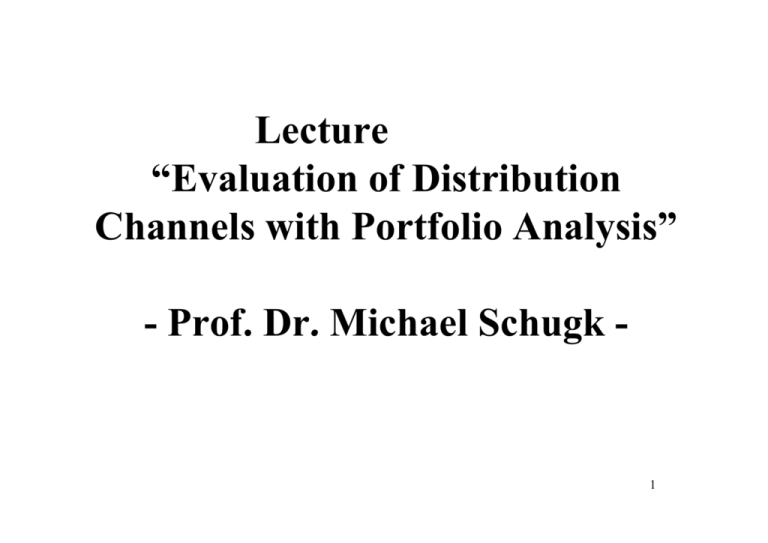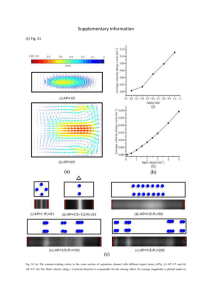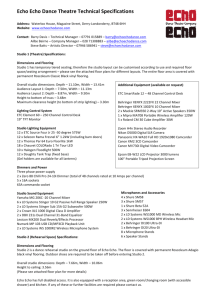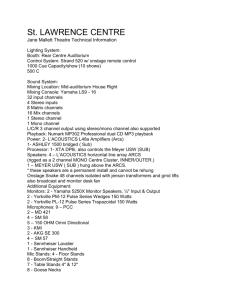Lecture “Evaluation of Distribution Channels with Portfolio Analysis
advertisement

Lecture “Evaluation of Distribution Channels with Portfolio Analysis” - Prof. Dr. Michael Schugk - 1 Definition of “distribution management” “Distribution management covers the design of distribution channels, the logistics of distribution channel management, managing the behaviour of distribution channel constituents, managing the retail effort, effort and international distribution distrib tion channel management.” Source: Panda; Sahadev (2005), p.vi 2 Management process for the distribution policy 1. Analysis of the distribution situation 2. Determination of distribution objectives 4. Determination of the distribution budget 5. Realization of distribution measures Designing of the distribution system Insert of the sales organization Designing of the logistics system 6. Distribution control Source: according to Bruhn (2007), p.248 In ntegration into the m marketing mix 3. Development of distribution strategy(ies) 3 Strategic decisions in the field of distribution policy • Design of distribution systems – Design of vertical and horizontal distribution channel structure • Vertical distribution channel structure (direct vs. indirect distribution) • Horizontal distribution channel structure (Number and kind of intermediaries per level) • Engagement of intermediaries – Selection – Steering – Motivation Source: Bruhn (2007), p.246 ff 4 Definition “distribution channel” and “multichannel distribution system” A distribution di t ib ti channel h l is i “… the route that the product follows from the manufacturer to the endendconsumer.. The distribution channel includes the manufacturer or consumer producer, wholesaler, retailers, logistics agents and consumers;” A multichannel distribution system is “… often called hybrid marketing channels. channels. Such multichannel marketing occurs when a single firm sets up two or more marketing channels to reach one or more customer segments. The use of multichannel systems has increased greatly in recent years. years ” Source: Grové (2005), p.270; Kotler (2008), p.343 5 Constitutive C i i distributive i i i tasks within i i the distributive value chain of the distribution channel Communication, presentation of goods & consulting Negotiating Logistics & enterprise resource planning Financing and payment transactions After-sales services O i i i off every single Optimization i l di distribution ib i task k as well ll as optimal i l integration of all distribution tasks into the total context of the distributive value chain; Source: according to Tomczak: (1999), p. 289. 6 Design of the distribution channel structure Distribution channel structure Vertical structure (Number of sales levels) Direct distribution Zero-level via sales representatives, e-commerce, e commerce, catalog selling, sales outlets etc. One-level Manufacturer Indirect distribution Two-level Manufacturer Horizontal structure (Breadth and depth) Multi-level Manufacturer Special wholesaler Wholesaler Breadth: Number of intermediaries per level (universal distribution, selective distribution distribution, exclusive distribution, sole distribution) General wholesaler Depth: Retailer Retailer End-customer Source: according to Bruhn (2007), p.250 Retailer Type of intermediaries per level (Types, e.g. speciality shop, 7 discounter etc.) Basic p principle p of direct distribution and indirect distribution (channel) Direct distribution Manufacturer--owned Manufacturer intermediaries Distribution of a manumanuf t facturer Indirect distribution Source: Kuhlmann (2001), p.50 End customer Manufacturer-external Manufacturerintermediaries 8 Options for the design of direct and i di t distribution indirect di t ib ti channels h l Intermediaries Manufacturer--owned intermediaries Manufacturer Manufacturer--external intermediaries Manufacturer • Board of management g • Sales representatives / sales department • Online distribution (E (E-commerce) commerce) • Manufacturer Manufacturer--owned sales outlets (e.g. factory outlet) • Manufacturer Manufacturer--owned call center • etc. • Types yp of the wholesale wholesale,, e.g. g - cash cash--andand-carry wholesaler (e.g. Metro) - etc. • Types of the retail retail,, e.g. - Specialty shop - Department store / mall - Catalog company - Supermarket / discounter - Specialty market - Filling station shops etc. Source: according to Bruhn (2007), p.250 ff 9 Definition of e-commerce and e-business e-business: supplier ee-commerce: commerce: e-business is the utilization of electronic systems / information and communication technologies (e.g. internet, intranet etc.) in support of all the activities / processes of business; manufacturer customer e-commerce consists of the buying y g and sellingg of products p or services (i.e. exchange of goods) over electronic systems such as the internet, EDI and other computer networks; 10 Multichannel Distribution system of a motor vehicle manufacturer Board of management; Sales representatives Sales department Segment of end-end consumers Manufacturer Sales outlets Authorized dealers Wholesaler Source: Kuhlmann (2001), p.57 11 Design of the distribution channel structure Distribution channel structure Vertical structure (Number of sales levels) Direct distribution Zero-level channel via sales representatives, e-commerce, e commerce, catalog selling, sales outlets etc. One-level channel Manufacturer Horizontal structure (Breadth and depth) Indirect distribution Two-level channel Multi-level channel Manufacturer Manufacturer Special wholesaler Wholesaler Breadth: Number of intermediaries per level (universal distribution, selective distribution distribution, exclusive distribution, sole distribution) General wholesaler Depth: Retailer Retailer End-customer Source: according to Bruhn (2007), p.250 Retailer Type of intermediaries per level (Types, e.g. speciality shop, 12 discounter etc.) Determination of the horizontal distribution channel structure according to the number of intermediaries per level (1) • Universal distribution – – – – Acceptance of all distribution intermediaries through the manufacturer Objecti e of high distrib Objective distribution tion quota, q ota i.e. ie Objective of all over availability of the products Example: cigarettes • Selective distribution – Acceptance of distribution intermediaries through manufacturer only in case of fulfillment of qualitative selection criteria, criteria e.g. eg • • • • • Consulting / service quality Price policy A Assortment width id h / assortment depth d h Size of store / location of store Willingness for co-operation etc. – Examples: household appliances, watches, musical instruments 13 Source: Bruhn (2007), p.259 f Determination of the horizontal distribution channel structure according to the number of intermediaries per level (2) • Exclusive distribution – Acceptance of distribution intermediaries through manufacturer f t only l in i case off fulfillment f lfill t off qualitative lit ti selection criteria and – qquantitative restrictions within selection of distribution intermediaries – Sole distribution as extreme case of exclusive distribution • Sole S l di distribution t ib ti – One single distribution intermediary usually for a certain distribution / sales area, i.e. – authorization for sole distribution – Examples: furnitures, juwelry, textiles Source: Bruhn (2007), p.260 14 Strategic decisions in the field of distribution policy • Design of distribution systems – Design of vertical and horizontal distribution channel structure • Vertical distribution channel structure (direct vs. indirect distribution) • Horizontal distribution channel structure (Number and kind of intermediaries per level) • Engagement of intermediaries – Selection – Steering – Motivation Source: Bruhn (2007), p.246 ff 15 Definition “channel design” “Channel design refers to the decisions that are taken k bby the h organization i i to form f a new distribution channel or secondly the decisions taken to change an existing distribution channel. channel ” Source: Strydom (2005), p.142 16 The steps p in the design g of a new distribution channel from the viewpoint of the manufacturer (1) • Determination of the distribution (channel) objectives • Specification of the distribution activities – Determination of distributive tasks within the distributive value chain in order to achieve the distribution objectives j • Development of the possible distribution channel alternatives – Normally quite a number of alternative distribution channels available • Number of sales levels • Number of intermediaries per level • Types of intermediaries per level 17 Source: Strydom (2005), p.142 ff The steps p in the design g of a new distribution channel from the viewpoint of the manufacturer (2) • Evaluation of the factors that may affect the selection of the distribution channel – External factors of success for the distribution – Organizational g / internal factors of success for the distribution • Selection of the best distribution channel (e.g. with portfolio analysis) • Selection l i off the h specific ifi intermediaries, i di i i.e. i – appointment of the specific intermediaries based on a list of criteria, e.g. • financial position of the intermediary • sales capacity • reputation etc. 18 Source: Strydom (2005), p.148 ff Basic structure of portfolio analysis for the evaluation and selection of different distribution channels Framework conditions (e.g. products / services, services customer segments) External factors of success Internal factors of success Variables of success (e.g. distribution distribution-channel--specific channel contribution margin, distribution quota, duration of customer relationship etc.) Object bj off success (here: ((hhere: h distribution d b channel channel) h l) l) Distribution-channel Distributionchannel--specific contribution margin = distribution channelchannel-related turnover for the manufacturer – distribution channelchannel-related costs for manufacturer 19 Source: Kuhlmann (2001), p.59 External e factors c o s of o success for o thee distribution d s bu o External factors of success as expression p for the relationshipp between different objects of success (here: (here: distribution channels / intermediaries); Attractiveness of the distribution channels / intermediaries (“How attractive is a certain distribution channel (“How compared d to other h distribution di ib i channels?”) channels h l ?”) Determination of the extent of attractiveness of distribution channels through external factors of success, that are wellwell-founded through • strategic resources of the distribution channels and • the compliance of customer requirements concerning distribution Source: Kuhlmann (2001), p.59 ff 20 Internal factors of success for the distribution Internal factors of success as expression for the relationship between the manufacturer and the object of success (here: (here: distribution channel / intermediaries) and the influence on the success of the manufacturer as a result of this relationship; relative competitive position of a manufacturer in regard to the distribution via a certain distribution channel (“How (“ How good is the manufacturer in dealing with a certain distribution channel compared to the main competitor dealing with the same distribution channel? channel?”) ”)) Source: Kuhlmann (2001), p.59 ff 21 Model ode for o thee de determination e o oof factors c o s oof success Internal factors of success External factors of success DC 1 M EC DC 2 ((PM) ((P)) DC 3 M = Manufacturer DC = Distribution channel PM = Product(s) of the manufacturer EC = End End--customer Source: Kuhlmann (2001), p.63 P = Product 22 Multidimensional point evaluation model (multidimensional scoring model) – checklist for dimension “attractiveness” of the distribution channel Di ib i channel Distribution h l … (A, (A B B, …)) C l Column 1 C l Column 2 C l Column 3 Criteria for „attractiveness“ of the distribution channel … Weighting ((0 to 2)) Assessment ((1 to 10)) Value data (0 = very unimportant; 2 = very important) (1 = very negative; 10 = very positive) Market share Efficiency Cost structure / turnover structure G Growth th potential t ti l Financial resources Distribution quota q … Coordinate = Total score Sum of weights =… … Sum of weights … Total score 23 Comparison of attractiveness of two different distribution channels Weighting Value Data Channel A Value Data Channel B 1) Market share 1.3 10.4 1.3 2) Efficiency 1.0 3.0 7.0 3) Cost / turnover structure 0.5 3.0 1.5 4) Growth potential 1.5 3.0 13.5 5) Financial resources 0.5 2.5 2.5 6) Distribution quota 1.0 4.0 9.0 Cooperation ability of the distribution channel 7) Management capacity 0.7 2.8 4.9 8) Motivation 1.3 7.8 3.9 9) Information systems 1.5 4.5 12.0 10) Logistics 0.8 5.6 3.2 Customer orientation of th distributhe distribu di t ib tion channel 11) Image 1.2 7.2 6.0 12) Assortment 0.7 2.8 2.8 13) Flexibility 1.0 5.0 4.0 14) Customer relationships 1.0 10.0 3.0 Sum 14.0 71.6 74.6 51 5.1 53 5.3 External factors of success Source: Kuhlm mann (2001), p.677 Competitive pposition of the distibu distibu-tion channel C di t Coordinate Assessment 1 2 3 4 5 6 7 8 9 10 Distribution channel A: A: manufacturer manufacturer--owned sales force (travelers), consignment / transport fleet, service department; 24 Distribution channel B: B: Internet with integrated call center, manufacturer manufacturer--external forwarder and service department; Comparison of relative competitive position for two different distribution channels Weighting Value Data Channel A Value Data Channel B 1) Share of turnover 1.5 12.0 3.0 2) Share of sales 1.0 7.0 3.0 3) Share of distribution costs 1.5 3.0 13.5 4) Structure of orders 0.8 6.4 3.2 5) Payment security 0.8 5.6 4.0 6) Offered assortment 1.0 6.0 6.0 7) Additional services 1.0 8.0 3.0 8) Product know-how 1.0 9.0 3.0 9) Information logistics 1.5 9.0 12.0 10) Goods logistics 1.0 6.0 8.0 11) Accurateness etc. 0.7 4.2 4.2 12) Cooperation capability 0.7 6.3 3.5 13) Solution of conflicts 0.5 4.5 2.0 14) Confidence 1.0 9.0 3.0 Sum 14.0 96 71.4 68 6.8 51 5.1 Internal factors of success Relative economical position Source: Kuhlm mann (2001), p.700 Relative perperformance position Relative position of customer relationships C di t Coordinate Assessment 1 2 3 4 5 6 7 8 9 10 Distribution channel A: A: manufacturer manufacturer--owned sales force (travelers), consignment / transport fleet, service department; 25 Distribution channel B: B: Internet with integrated call center, manufacturer manufacturer--external forwarder and service department; Channel B: 5.3 / 5.1 0 Source: Kuhlmann (2001), p.71 Channel A: 5.1 / 6.8 Actu ual state Attraactivenesss of the cchannel (exteernal facttors of su uccess) Targett state Portfolio for two different distribution channels 10 Relative competitive position of the channel (internal factors of success) 26 Portfolio analysis for the evaluation of di t ib ti channels distribution h l / types t off intermediaries i t di i Attracttiveness of the ch hannel (extern nal facto ors of succcess) 100 IInvestment Investmentt t- andd growth strategies high Selective strategies 67 Absorption and dis dis-investment strategies middle 33 low 0 low 33 middle 67 high 100 Relative competitive position of the channel (internal factors of success) Source: Berndt; Fantapié Altobelli; Sander (1997), p.362 27 Cited literature in lecture “Sales, services, and product disposal Berndt, Ralph; Fantapié Altobelli, Claudia; Sander, Matthias: Internationale MarketingMarketing-Politik. Berlin, Heidelberg, New York: Sp Springer ringer Verlag, 1997 Bruhn, Manfred: Marketing. Grundlagen für Studium und Praxis. 8., überarbeitete Auflage. Wiesbaden: Betriebswirtschaftlicher Verlag Verlag Dr. Th. Gabler, 2007 Kuhlmann Eberhard: Industrielles Vertriebsmanagement Kuhlmann, Vertriebsmanagement. München: Verlag Franz Vahlen Vahlen, 2001 Strydom, Johan: Channel design and the selection of channel members. In: Strydom, Johan (Editor): Distribution Management. The The place Decision. Second edition. Varemont: New Africa Books, 2005, p.141 – 164 Strydom, Johan (Editor): Distribution Management. The place Decision. Second edition. Varemont: New Africa Books, 2005 Panda, Tapan K.; Sahadev, Sunil: Sales and Distribution Management. New Delhi: Oxford University Press, 2005 Tomczak, Torsten: Alternative Vertriebswege. St. Gallen: Verlag Thexis, 1999 28 29 30 31




